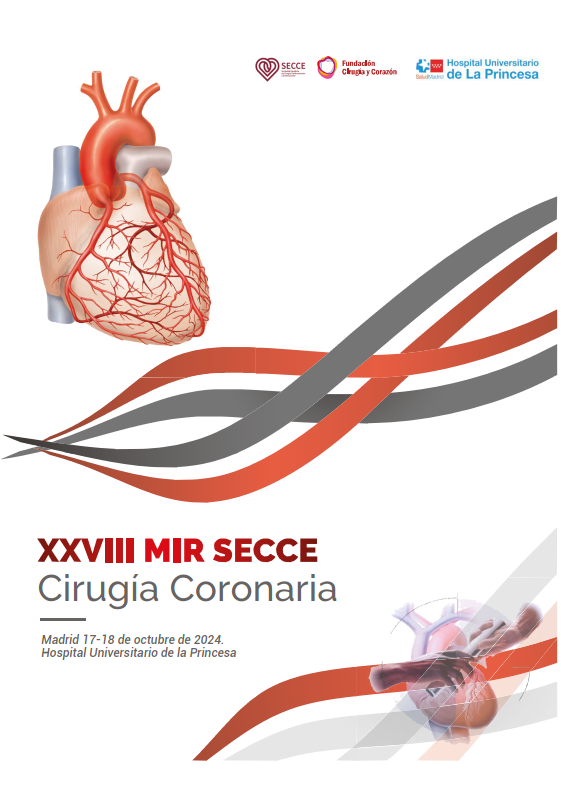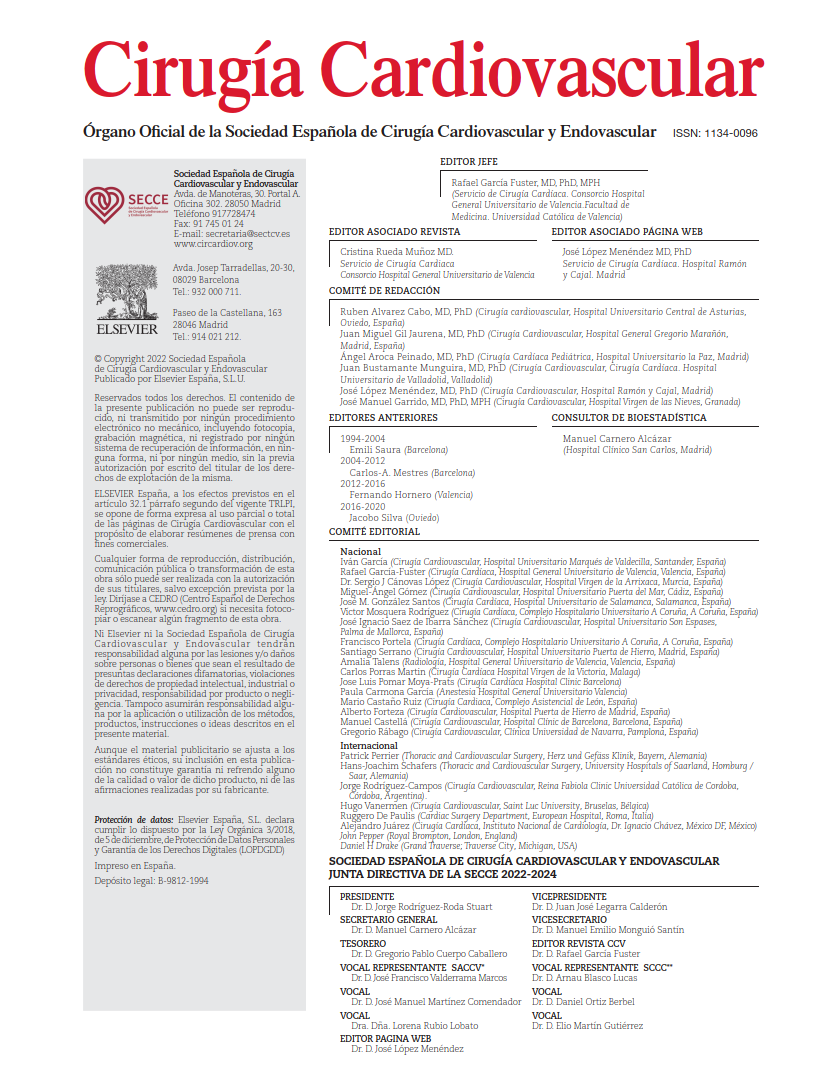Cardiac surgery has evolved rapidly, increasing the complexity of the interventions performed. Nowadays, it is not uncommon to encounter patients with two or more previous surgical procedures in daily clinical practice.
Historically, reoperations in valvular surgery have been associated with higher morbidity and increased surgical risk. Despite this, the surgical outcomes of multivalve reoperations remain poorly characterized in the medical literature, and there is a general lack of knowledge regarding the relationship between patient characteristics, technical surgical components, and their impact on operative mortality.
This review evaluates 2,352 reoperations performed in a single institution between 2008 and 2022, aimed at repairing and/or replacing two or more heart valves in 2,324 patients. The analysis included patients who required concomitant coronary artery bypass grafting (CABG) and/or atrial fibrillation ablation, while those undergoing aortic and/or aortic root surgery were excluded.
The primary objective of the study was to analyze operative mortality. Secondary objectives included identifying and quantifying intraoperative adverse events and major postoperative morbidity (prolonged ventilation, deep sternal wound infection, permanent stroke, postoperative renal failure, and/or cardiac reoperation).
The previous valvular procedures performed were: aortic valve repair (3.7%), aortic valve replacement (33%), mitral valve repair (27%), mitral valve replacement (25%), tricuspid valve repair (8.1%), tricuspid valve replacement (1.1%), and pulmonary valve surgery (2.1%). A total of 37% of patients had undergone previous CABG, with 64% of them having an internal mammary artery graft, and in 12%, one of the grafts crossed the midline.
The mean time since the previous surgery was 9.5 years. The procedures were elective in 56% of cases, urgent in 43%, and emergent in 0.81%.
Cardiopulmonary bypass was initiated before resternotomy in 2.9% of cases. In 80% of cases, two valves were operated on, while three valves were involved in the remaining 20%. The most frequent combined valve procedures were mitral valve replacement + tricuspid annuloplasty (29%), aortic valve replacement + mitral valve replacement (15%), and mitral valve repair + tricuspid repair (12%).
The aortic valve was repaired or replaced in 55% of cases, while the mitral valve was repaired or replaced in 89%. Nearly half (46%) of cases required a concomitant non-valvular procedure, including CABG in 22% and atrial fibrillation ablation in 25%.
For each additional surgical technique performed, operative mortality increased significantly, from 2.4% for two procedures or techniques to 17% for five or more.
Intraoperative injuries to cardiovascular structures occurred in 1.6% of cases (37 patients), with the most frequently affected structure being the aorta (19% of cases).
A total of 29% of patients required mechanical ventilation for more than 24 hours, 7.1% developed postoperative renal failure, and 6.3% required renal replacement therapy. The stroke rate was 1.8%. Infectious complications leading to sepsis occurred in 2.1% of cases, while deep sternal wound infection was reported in 0.17%. Reoperation for bleeding was necessary in 3.9% of cases. The median intensive care unit stay was 89 hours, and the total postoperative hospital stay averaged 10 days.
Hospital mortality was 3.9%, while operative mortality (defined as death occurring within the first 30 days post-surgery) was 4.2%. This mortality was lower in elective, isolated multivalve surgery without concomitant procedures, with hospital mortality at 1.6% and operative mortality at 1.7%.
Statistical analyses identified the variables associated with increased operative mortality, ranked by importance: concomitant CABG, renal dysfunction (BUN >25 mg/dL), left ventricular dysfunction (LVEF <45%), advanced functional class (NYHA stage III or IV), urgent or emergent surgery, preoperative anemia (hematocrit <37%), number of surgical techniques performed, and presence of peripheral artery disease.
Interestingly, no increase in operative mortality was observed in cases of multivalve surgery for active endocarditis.
The authors concluded that multivalve surgical reoperations can be performed with low mortality, emphasizing that surgical complexity and preexisting physiological factors are crucial in the decision-making process, as they significantly influence operative risk.
COMMENTARY:
The most remarkable aspect of this study is the excellent outcomes in elective multivalve reoperations, with mortality below 2%. These results were obtained in a high-volume, prestigious institution, raising the question of whether they can be extrapolated to centers with lower volume and experience.
A thorough analysis of the study suggests that, as previously recommended by the authors, achieving favorable outcomes in reoperations requires a standardized multidisciplinary approach, with detailed preoperative planning to establish a primary strategy and alternative plans tailored to the procedure and the patient’s anatomical characteristics. Imaging studies, particularly CT scans, play a crucial role in guiding these procedures, and in highly complex cases, 3D models may help anticipate potential complications in technically demanding surgeries.
The complexity of the decision-making process is fundamental in cardiac surgery. The first and most important challenge is determining whether a patient should undergo surgery. The second, once surgery is indicated, is selecting the most appropriate procedure(s) to achieve the best outcomes. In general, the goal in complex surgeries should be to perform the most essential and expeditious intervention possible. The value of this study lies in its ability to provide insights into the subset of reoperated patients requiring multivalve surgery (involving two or more valves) and its significant external validity in risk stratification.
Based on these findings, strategies to optimize and prevent non-cardiac comorbidities and prehabilitation programs, all within the framework of enhanced recovery after surgery (ERAS) protocols, gain particular importance.
This study clearly demonstrates that adding additional procedures in such high-risk interventions increases surgical risk. Determining the optimal number of procedures for a specific patient is challenging, raising several questions for future research:
- What would be the outcomes of hybrid procedures combining percutaneous revascularization of non-LAD arteries before multivalve reoperations in patients with coexisting coronary artery disease?
- What role can transcatheter therapies play in managing previously operated multivalve disease?
- Are hybrid (surgical and transcatheter) approaches feasible for patients with degenerative aortic valve disease, functional mitral regurgitation, or functional tricuspid regurgitation in the context of multivalve reoperations?
These unanswered questions pave the way for further studies that, like this one, may provide valuable data to enhance decision-making in cardiac surgery.
Once again, the importance of institutional Heart Teams is highlighted. The concept of “Life Time Management” should be increasingly present in decision-making for patients with valvular heart disease to maximize life expectancy while minimizing the cumulative risk of future procedures.
Undoubtedly, our specialty faces challenging and unknown scenarios to which surgical strategies will need to adapt.
REFERENCES:
Insler JE, Tipton AE, Bakaeen FG, Bakhos JJ, Houghtaling PL, Blackstone EH, et al. What determines outcomes in multivalve reoperations? Effect of patient and surgical complexity. J Thorac Cardiovasc Surg. 2024 Dec;168(6):1632-1642.e2. doi: 10.1016/j.jtcvs.2023.12.005.
Kindzelski BA, Bakaeen FG, Tong MZ, Roselli EE, Soltesz EG, Johnston DR, et al.; Cleveland Clinic Collaboration on Cardiac Reoperations Working Group Collaborators. Modern practice and outcomes of reoperative cardiac surgery. J Thorac Cardiovasc Surg. 2022 Dec;164(6):1755-1766.e16. doi: 10.1016/j.jtcvs.2021.01.028.



